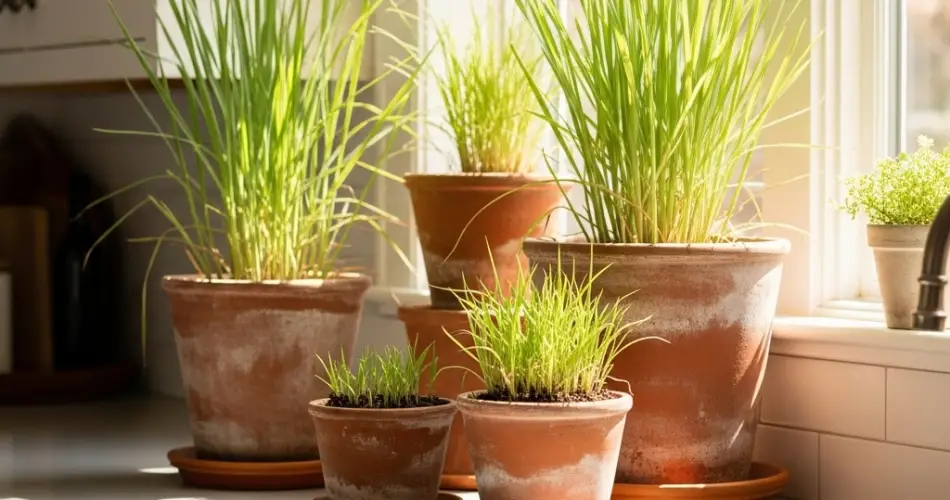Lemongrass is one of those unique herbs that instantly lifts a dish with its bright citrus aroma and clean flavor. A staple in Southeast Asian cuisine, this tropical grass is used in soups, curries, teas, and marinades. While it’s often associated with lush outdoor gardens, lemongrass is surprisingly easy to grow indoors—right in your kitchen.
If you enjoy cooking with fresh herbs or want to add a touch of greenery and fragrance to your kitchen, lemongrass is an excellent choice. With a bit of light and regular care, you can have a steady supply of this versatile herb at your fingertips all year round.
Why Grow Lemongrass Indoors?
Growing lemongrass indoors offers both culinary and practical advantages. It requires minimal space, looks decorative with its long, arching green blades, and naturally repels insects. When grown in a pot near a sunny kitchen window, lemongrass provides quick and easy access for cooking while bringing a touch of the tropics into your home.
Benefits of growing lemongrass in your kitchen:
-
Fresh, chemical-free herb supply
-
Convenient access for cooking
-
Compact growth in containers
-
Decorative and fragrant greenery
-
Natural mosquito and pest repellent
What You’ll Need to Start
To grow lemongrass successfully indoors, gather these basic materials:
-
A healthy lemongrass stalk or seedling
-
A deep pot with drainage holes (at least 20–25 cm deep)
-
High-quality, well-draining potting soil
-
A sunny windowsill or a grow light
-
Watering can or spray bottle
Lemongrass grows in tight clusters and has a fibrous root system, so a pot with both depth and width will give it the space it needs.
Starting Lemongrass from Store-Bought Stalks
One of the simplest ways to grow lemongrass is to start from a fresh stalk, which you can often find in grocery stores or Asian markets. Here’s how:
-
Choose a fresh, firm stalk with a base that’s still intact.
-
Remove any dry or brown outer layers.
-
Place the stalk in a glass of water, submerging the bottom 5–7 cm.
-
Set the glass in a sunny window and change the water every two days.
After about a week, you should see small roots forming at the base. Once the roots are 2–4 cm long, it’s time to transplant the stalk into soil.
Planting in Pots
Fill your pot with a well-draining mix—regular potting soil mixed with some perlite or coarse sand works well. Plant the rooted stalk upright, with the base just below the surface and the green top exposed. Water gently after planting to help settle the soil.
Place the pot in a sunny kitchen window where the plant can receive at least 6 hours of direct sunlight daily. If you don’t get enough natural light, consider using a grow light to supplement.
Watering and Feeding
Lemongrass enjoys consistently moist soil but dislikes sitting in water. Water the plant when the top 2–3 cm of soil feels dry. In warmer indoor environments, daily watering may be necessary.
Feed your lemongrass monthly with a diluted liquid fertilizer or organic compost tea. During the growing season (spring through early fall), regular feeding encourages lush, vigorous growth.
Maintenance and Growth Tips
-
Rotate the pot regularly so the plant grows evenly on all sides.
-
Trim back dead or yellowing leaves to encourage fresh new growth.
-
Divide the plant every 8–12 months if it becomes root-bound or outgrows its container.
Lemongrass is generally pest-resistant but watch for any signs of aphids or spider mites. A light spray of neem oil or soapy water can resolve minor infestations.
Harvesting Lemongrass
You can begin harvesting lemongrass when the stalks reach about 1–1.5 cm in diameter and are firmly rooted. Use a clean, sharp knife or garden scissors to cut the stalk at the base near the soil line.
-
Use the white bulbous end for cooking—this is the most flavorful part.
-
Chop the green tops to brew herbal teas or dry for later use.
Harvest a few stalks at a time, allowing the plant to continue producing. The more often you harvest, the more the plant will grow.
Culinary Uses
Fresh lemongrass adds a unique citrus flavor to many dishes. Use it in:
-
Thai soups like Tom Yum
-
Curries and stews
-
Herbal teas and infusions
-
Marinades for chicken or seafood
-
Stir-fries and rice dishes
To use in cooking, peel the tough outer layers and finely chop or bruise the inner stalk. You can also freeze whole stalks for future use.
Conclusion
Lemongrass is a fragrant, flavorful herb that brings tropical flair and culinary value to your kitchen. Growing it in pots indoors is simple and satisfying, even if you live in an apartment or have no garden space. With just a bit of light, water, and attention, you can enjoy this versatile herb in your cooking year-round. Bring home a stalk, pot it up, and experience the freshness of lemongrass in every dish—right from your kitchen windowsill.



